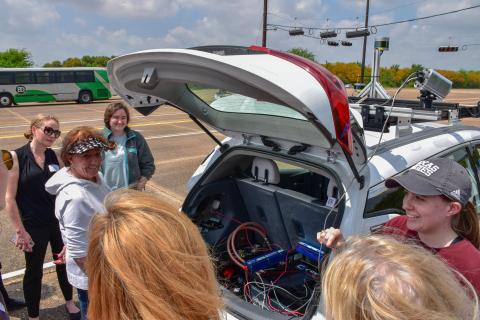Planes, Trains and Automobiles: EWP Members Get Behind the Scene Look at Texas’ Transportation Network
Published Apr 17, 2019 by Julia McGowen
For a sprawling state like Texas, a strong transportation network is vital to everyday life, and intrinsically tied to economic development and quality of life.
To further explore this network and how women are shaping the transportation industry for our region, the Partnership’s Executive Women’s (EWP) Partnership Program’s annual retreat, entitled “Planes, Trains and Automobiles,” spanned two days, packed with immersive presentations, demonstrations and interactive experiences.
The retreat, held in Bryan–College Station, partnered with the Texas Transportation Institute (TTI) and Texas A&M University to offer EWP members behind the scenes looks at many innovations happening in the transportation industry.
On day one, attendees participated in presentations from key regional leaders at the Center for Infrastructure Renewal (CIR) and viewed a smart intersection demonstration as well as a hands-free AutoDrive Electric Car demonstration. The group also toured CIR’s brand new building at Texas A&M’s RELLIS campus, a premier, high-tech research, technology development and education campus, which includes the Structural and Materials Testing Facility, the Asphalt Innovation Laboratory and the soon-to-be home of the Army Futures' lab.
EWP members then traveled to tour the Texas A&M Engineering Extension (TEEX) Brayton Fire Training Field, where more than 194,000 emergency responders from all 50 states and 81 countries train every year and viewed Disaster City, which has training modules for collapsed buildings and extreme disaster response.
Day two began with a panel discussion featuring EWP members Michelle Brown, Managing Director, Customer Experience, United Airlines, Marcia Faschingbauer, President and CEO, Excargo Services Inc., and Brenda Mainwaring, Vice President, Public Affairs, Union Pacific Railroad Company, as they shared insight into the current trends in the airline, railroad and cargo/logistics industries.
Attendees were joined by the Texas A&M Mays Business School and learned details on their Professional MBA program in Houston before traveling to Texas A&M’s campus to tour the new, top-notch Zachry Engineering Education Complex, which currently has 19,000 engineering students enrolled, to learn more about Texas A&M’s aerospace research from John L. Junkins, Ph.D.
Executive Women's Partnership (EWP) is Houston’s premier networking group for female executives. Open to member companies with $100M-plus revenue, this program offers members invitations to several exclusive and intimate gatherings throughout the year. In addition to receiving VIP behind-the-scenes looks at our member companies and peer-to-peer networking opportunities. For information on joining EWP, click here.
 The Houston Report
The Houston Report




















